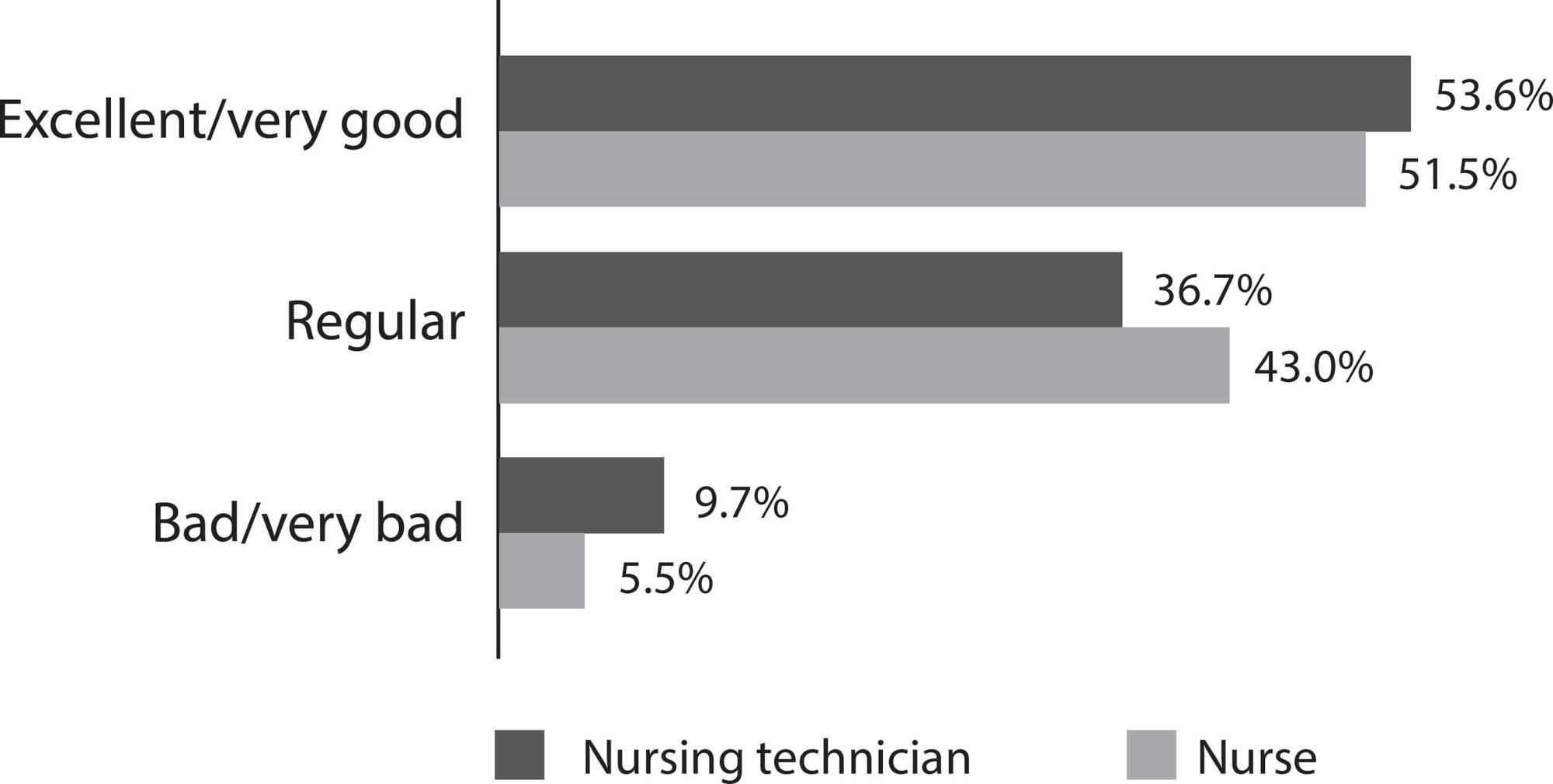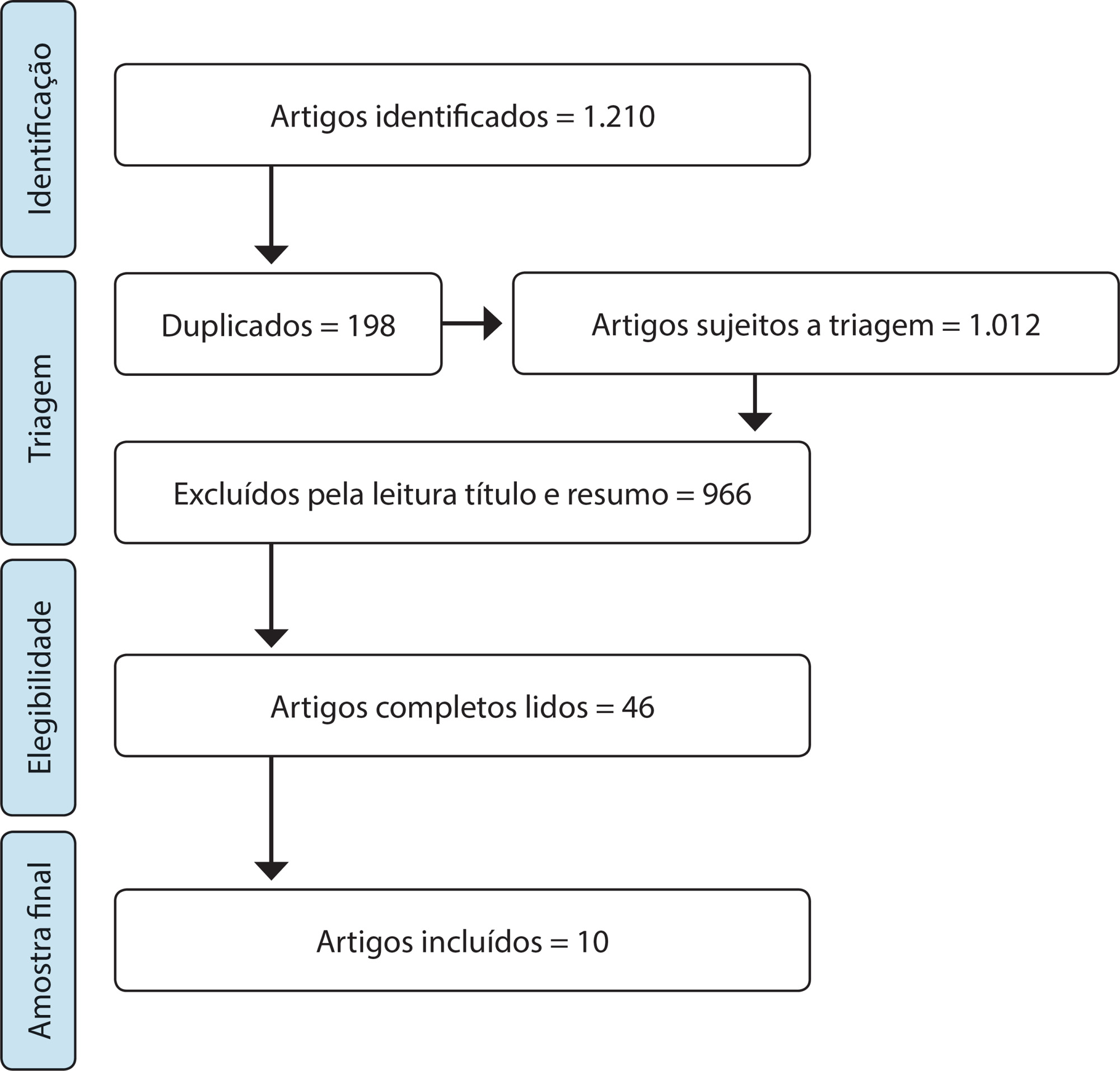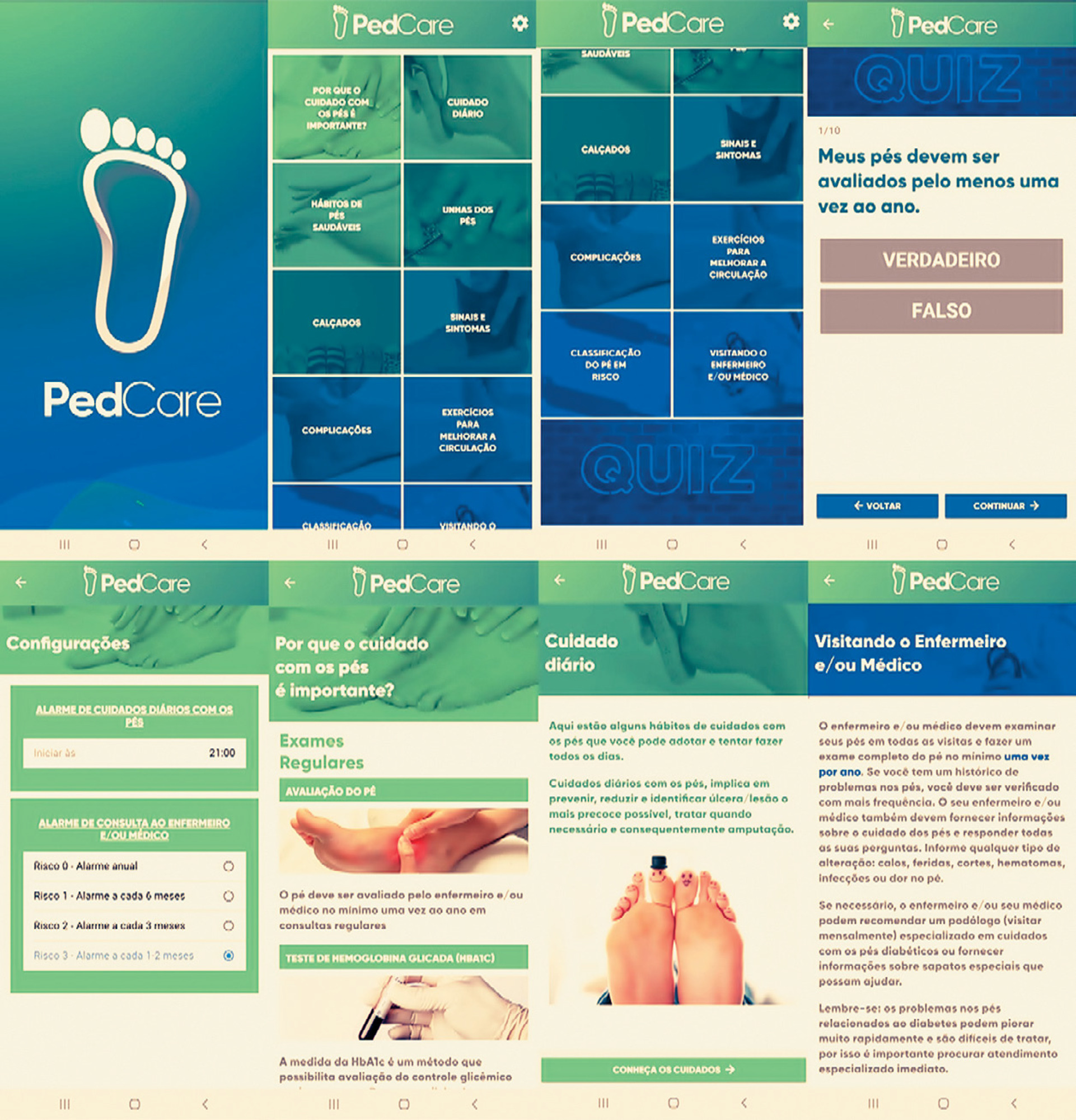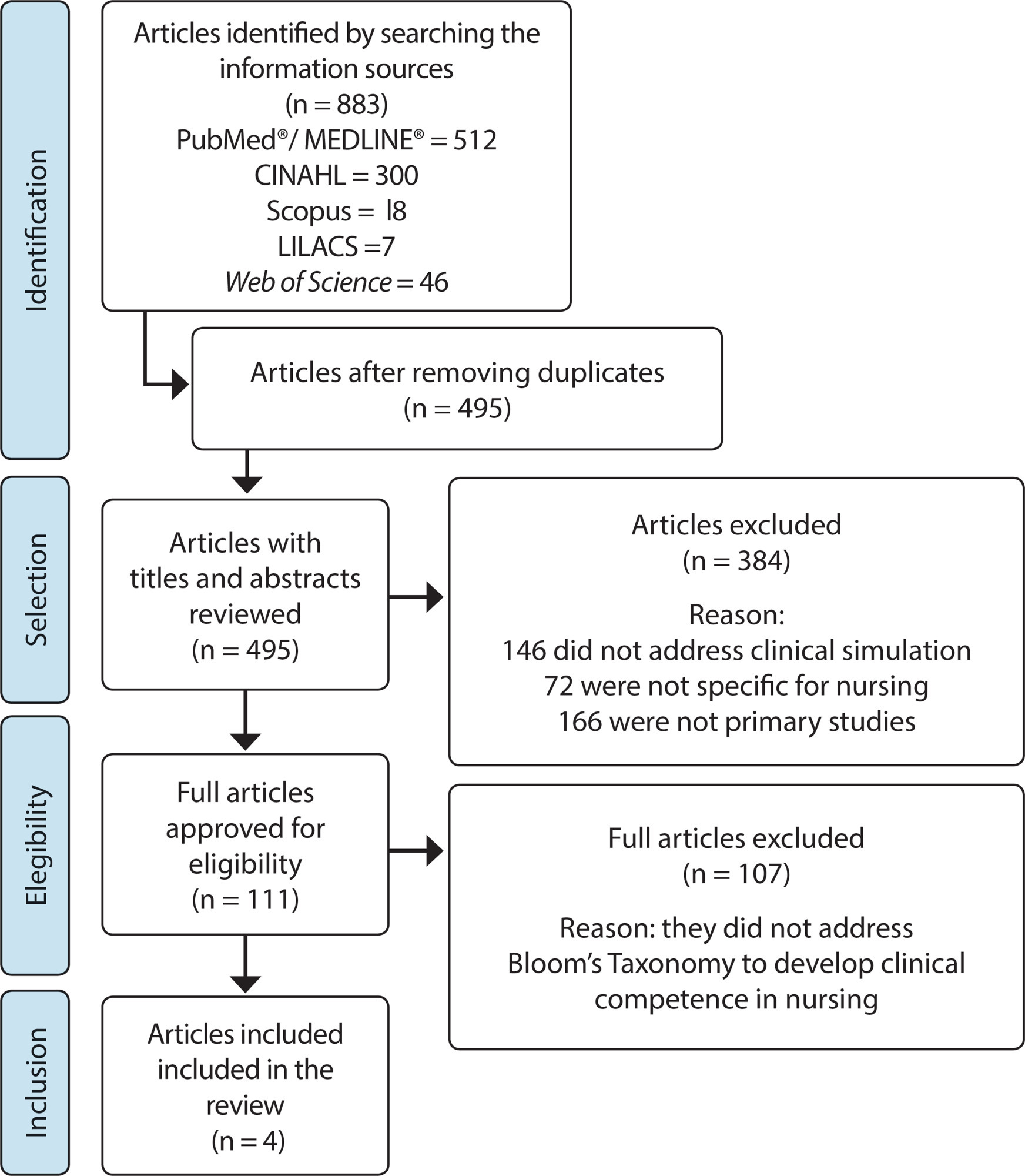-
PESQUISA01/01/2018
Introduction of the School Health Program in the city of Cascavel, Paraná State: report of nurses
Revista Brasileira de Enfermagem. 2018;71:1540-1547
Resumen
PESQUISAIntroduction of the School Health Program in the city of Cascavel, Paraná State: report of nurses
Revista Brasileira de Enfermagem. 2018;71:1540-1547
DOI 10.1590/0034-7167-2017-0188
Visualizações1Ver maisABSTRACT
Objective:
to understand the introduction of the School Health Program in the city of Cascavel, Paraná State, as opposed to the report of nurses.
Method:
a qualitative study with fifteen participants. The data were collected from April to August 2015, through semi-structured interviews, analyzed by content analysis and thematic modality.
Results:
the category “Introduction process” of the School Health Program integrates the subcategories “Identified health problems” and the “Challenges of intersectoriality”. The program was implemented quickly, with a fragile training of professionals to perform in the phases that compose it. Structural conditions of schools, human and material resources, and emerging intersectoral interaction were identified obstacles. The integration of the health, school, and family constitutes the program’s potentiality.
Final considerations:
it is understood that the actions of the program were based on health assessments of students, and it is necessary for professionals and managers to discuss and analyze the obstacles identified to achieve all the proposed objectives.
-
PESQUISA01/01/2018
Teaching-learning tendencies and strategies used in the leadership development of nurses
Revista Brasileira de Enfermagem. 2018;71:1531-1539
Resumen
PESQUISATeaching-learning tendencies and strategies used in the leadership development of nurses
Revista Brasileira de Enfermagem. 2018;71:1531-1539
DOI 10.1590/0034-7167-2017-0455
Visualizações0Ver maisABSTRACT
Objective:
To identify the tendencies and teaching-learning strategies used for leadership development in the discipline Nursing Administration in higher education institutions in Brazil.
Method:
Non-experimental, type survey, descriptive and exploratory, cross-sectional, with quantitative approach.
Results:
The dialogued lecture strategy was cited as used by 241 (91%) professors, followed by research, by 237 (89%), and discussion or group work, by 221 (83%). Strategies not used were: spiral learning, 166 (63%), and online programs, 151 (57%) professors. The strategy that presents higher tendency of use is that of online courses, 104 (39%).
Conclusion:
among the strategies mentioned, all are aligned with the directions given in the literature for nursing education, but these strategies and methodologies influence the formation of leader nurses differently.
-
PESQUISA01/01/2018
Plataforma PEnsinar®: a learning tool for teaching the nursing process
Revista Brasileira de Enfermagem. 2018;71:1522-1530
Resumen
PESQUISAPlataforma PEnsinar®: a learning tool for teaching the nursing process
Revista Brasileira de Enfermagem. 2018;71:1522-1530
DOI 10.1590/0034-7167-2016-0411
Visualizações0Ver maisABSTRACT
Objective:
to describe the construction and transition phases undertaken in the development of a virtual learning environment named Plataforma PEnsinar® (PEnsinar Platform®). This platform aims at teaching the nursing process and the nursing classifications NANDA International, NIC, NOC and ICNP®.
Method:
this is a methodological and technological development research that used construction and transition phases of the software development process named Rational Unified Process.
Results:
the software was developed in the construction phase. Unit and integration tests of components of interfaces were held. In the transition phase, the complete system was showed to the users. It was completely working considering the applicability and employment, under conditions to be implemented and evaluated.
Conclusion:
the study showed how the construction and transition phases of the Plataforma PEnsinar® were developed. It was based on a proposal that inserts the student as an active agent in the nursing process and the professor as a mediator, providing tools that will contribute to a better learning.

-
PESQUISA01/01/2018
Clinical and management skills for hospital nurses: perspective of nursing university students
Revista Brasileira de Enfermagem. 2018;71:1514-1521
Resumen
PESQUISAClinical and management skills for hospital nurses: perspective of nursing university students
Revista Brasileira de Enfermagem. 2018;71:1514-1521
DOI 10.1590/0034-7167-2017-0452
Visualizações0Ver maisABSTRACT
Objective:
to analyze nursing university students’ perception of the professional skills to act in the hospital setting developed during their academic training, and what strategies are being created for the development of these skills during their performance.
Method:
an exploratory, qualitative study in which 40 nursing university students participated. The data were collected from September to December 2016 and conducted thematic inductive analysis.
Results:
clinical skills were identified that could be learned and previously developed at the undergraduate level; and management skills learned during undergraduate education and developed only in the hospital environment. Strategies for the development of skills were identified, such as individual study and Permanent Education, by the employing institution.
Final considerations:
it was evidenced that college contributed in significant proportions for learning and development of some clinical and management skills in the hospital. Still, despite the identified strategies, managers and training centers need to continuously implement strategies for the development of new skills in nurses.
-
PESQUISA01/01/2018
Nursing educational intervention for the identification of Adverse Events in hemodialysis
Revista Brasileira de Enfermagem. 2018;71:1507-1513
Resumen
PESQUISANursing educational intervention for the identification of Adverse Events in hemodialysis
Revista Brasileira de Enfermagem. 2018;71:1507-1513
DOI 10.1590/0034-7167-2017-0843
Visualizações0Ver maisABSTRACT
Objective:
To develop an educational program aimed at the qualification of the nursing technicians that makes possible the understanding of Adverse Events (AE), aiming to adapt the data records; to elaborate tools for the records of the AE in hemodialysis patients; and to assess the knowledge before and after the educational program.
Method:
An educational intervention was conducted through a classroom and online course on how to recognize and record AE in hemodialysis. The effectiveness of the program was assessed through the gain of knowledge measured through online record of the AE in fictitious problem cases before and after the course.
Result:
Sixteen nursing technicians participated in the study. In the initial test, the mean score was 3.7 ± 0.3 points and in the final assessment was 4.2 ± 0.3 points (p=0.0002).
Conclusion:
It was possible to verify that the educational intervention contributed to increase the knowledge of the participants and that the training of these can be achieved with classroom and online learning courses.
-
PESQUISA01/01/2018
Nursing laboratory and critical education of nurses: approaches and distances
Revista Brasileira de Enfermagem. 2018;71:1500-1506
Resumen
PESQUISANursing laboratory and critical education of nurses: approaches and distances
Revista Brasileira de Enfermagem. 2018;71:1500-1506
DOI 10.1590/0034-7167-2017-0339
Visualizações1Ver maisABSTRACT
Objective:
to analyze the contribution of the laboratory of nursing to the critical education of nurses.
Method:
qualitative study, conducted among 18 professors of higher education institutions, being one public and the other private. Data were collected between February and November of 2016 by means of semi-structured interview. To analyze data, it was used a content analysis in the thematic modality.
Results:
it was observed the emphasis in the technical skills development by propagation of behavior and practices; the creation of bonds between professors and students happens on the limit of good interpersonal relationship; the laboratory of nursing may help the critical reflection about the practice, being a place that allows the learning of ethics.
Final considerations:
the nurse education, carried out by the laboratory of nursing, have to overcome the emphasis in the uncritical reproduction of practices and to observe the nurse’s power to think about the reality in the meaning of its modification.
-
PESQUISA01/01/2018
Students’ knowledge of metabolic syndrome after educational intervention
Revista Brasileira de Enfermagem. 2018;71:1493-1499
Resumen
PESQUISAStudents’ knowledge of metabolic syndrome after educational intervention
Revista Brasileira de Enfermagem. 2018;71:1493-1499
DOI 10.1590/0034-7167-2017-0342
Visualizações1Ver maisABSTRACT
Objective:
To analyze the knowledge of children and adolescents about risk factors for metabolic syndrome (MS) before and after educational interventions.
Method:
A quasi-experimental, comparative, prospective and intervention study conducted in 2015 and 2016 with 43 students in the city of Picos (state of Piauí-PI). Five health education meetings were held. For the knowledge analysis, was applied a questionnaire at three different moments.
Results:
Participants’ mean age was 12.6 years (± 2.1), of which 60.5% were female. The ‘More than good’ level of knowledge went from 20.9% to 55.8% after interventions. When evaluated late, students maintained a higher level of knowledge compared to before the interventions. Most said they were able to change their lifestyle after educational meetings.
Conclusion:
The educational intervention promoted increase of knowledge and stimulated changes in attitudes related to risk factors associated with MS.
-
PESQUISA01/01/2018
Work engagement among participants of residency and professional development programs in nursing
Revista Brasileira de Enfermagem. 2018;71:1487-1492
Resumen
PESQUISAWork engagement among participants of residency and professional development programs in nursing
Revista Brasileira de Enfermagem. 2018;71:1487-1492
DOI 10.1590/0034-7167-2017-0278
Visualizações0Ver maisABSTRACT
Objective:
to assess the levels of engagement at work of nurses enrolled in multi-professional residency and professional development programs in health care of a Brazilian public institution.
Method:
a cross-sectional study with 36 professionals. The data were collected in September 2013, with use of the Utrecht Work Engagement Scale (UWES), composed of seventeen self-evaluation items with the dimensions vigor, dedication and absorption, as well as an overall score.
Results:
the levels of engagement ranged from 3.8 to 4.3, and the standard deviations, between 1.1 and 1.3. Nurses showed average levels on vigor (3.8) and absorption (3.9) dimensions, and high levels on dedication (4,3) and engagement (4.0).
Conclusion:
the professionals presented good levels of energy, resilience, enthusiasm and involvement with the work. They are satisfied with the activity and are dedicated to it, which promotes the acquisition of skills and competences along the in-service training, ensuring a future professional practice of quality.
-
ARTÍCULO ORIGINAL21/10/2019
Occupational stress and engagement in primary health care workers
Revista Brasileira de Enfermagem. 2019;72(6):1580-1587
Resumen
ARTÍCULO ORIGINALOccupational stress and engagement in primary health care workers
Revista Brasileira de Enfermagem. 2019;72(6):1580-1587
DOI 10.1590/0034-7167-2018-0681
Visualizações0Ver maisABSTRACT
Objective:
To evaluate levels of occupational stress and work engagement among primary health care workers.
Method:
A descriptive, correlational and transversal study was carried out in a small municipality in the countryside of São Paulo, with a non-probabilistic sample of convenience, with 85 workers. Three self-applied instruments were used: one developed by researchers, containing sociodemographic variables; Work Stress Scale (WSS) and Utrech Work Engagement Scale (UWES).
Results:
Prevalence of women (72.6%), 40 years old or more (45.9%), 4 years and 4 months of mean working time in primary care. Thirty-one workers (36.5%) presented significant stress (scores ≥2.5). Work engagement showed a mean of 4.1 (±1.2) to 4.4 (±1.4), classified as high in all dimensions. Occupational stress and work engagement correlated negatively.
Conclusion:
Workers presented high levels of work engagement; more than one-third had significant occupational stress. Workers with high levels of occupational stress tend to have lower work engagement.
-
ARTÍCULO ORIGINAL01/07/2020
Patient safety culture: perception of nursing professionals in high complexity institutions
Revista Brasileira de Enfermagem. 2020;73(5):e20190174
Resumen
ARTÍCULO ORIGINALPatient safety culture: perception of nursing professionals in high complexity institutions
Revista Brasileira de Enfermagem. 2020;73(5):e20190174
DOI 10.1590/0034-7167-2019-0174
Visualizações1Ver maisABSTRACT
Objectives:
to analyze the perception of nursing professionals about patient safety culture in three highly complex hospital institutions.
Methods:
descriptive and quantitative study with professionals working in care. The Hospital Survey on Patient Safety Culture questionnaire was applied, classifying its dimensions according to the percentage of positive responses (strengthened: ≥75.0%; potential for improvement: <75.0% to> 50.0%; weakened: ≤50.0%).
Results:
four hundred sixty-seven professionals (79.6%), mostly women (88.4%), nursing technicians/assistants (57.2%), 20 to 39 years (60.8%), less than five years in the institution (57.8%) and exclusive bond (79.2%) participated in the study. Safety culture was considered fragile, seven dimensions assessed as such, highlighting “Openness to communication” and “Non-punitive responses to errors” with <30.0% positive responses.
Conclusions:
evidence of the need for discussion of the subject and strategies for change that promote quality and safety of care.

-
ARTÍCULO DE REVISIÓN06/11/2020
Cuidado transicional aos cuidadores de idosos dependentes: revisão integrativa da literatura
Revista Brasileira de Enfermagem. 2020;73:e20200394
Resumen
ARTÍCULO DE REVISIÓNCuidado transicional aos cuidadores de idosos dependentes: revisão integrativa da literatura
Revista Brasileira de Enfermagem. 2020;73:e20200394
DOI 10.1590/0034-7167-2020-0394
Visualizações0Ver maisRESUMO
Objetivo:
Identificar as necessidades dos cuidadores de idosos dependentes para o autocuidado na transição do hospital para casa.
Métodos:
Revisão integrativa que seguiu um protocolo pré-definido, realizada de março a maio de 2019, nas plataformas EBSCO, B-On, Scopus, Web of Science e Joanna Briggs Institute. Foram definidos descritores e critérios de elegibilidade para a amostra bibliográfica, que ficou constituída por dez artigos. Pela atualidade da evidência, limitou-se a pesquisa aos anos de 2015 a 2019.
Resultados:
As necessidades de cuidados transicionais para os cuidadores agrupam-se em cinco categorias: necessidades na transição para o papel de cuidador, necessidades de autocuidado dele próprio, necessidades de saúde, necessidades econômicas e necessidades sociais e comunitárias.
Considerações finais:
O cuidado transicional para os cuidadores deve ter dois focos de atenção, por parte dos enfermeiros: a gestão dos cuidados ao familiar dependente e a gestão das necessidades e dos cuidados ao próprio cuidador.

-
ARTÍCULO ORIGINAL24/05/2021
PEDCARE: validação de um aplicativo móvel sobre o autocuidado com o pé diabético
Revista Brasileira de Enfermagem. 2021;74:e20200856
Resumen
ARTÍCULO ORIGINALPEDCARE: validação de um aplicativo móvel sobre o autocuidado com o pé diabético
Revista Brasileira de Enfermagem. 2021;74:e20200856
DOI 10.1590/0034-7167-2020-0856
Visualizações0RESUMO
Objetivo:
descrever o processo de validação de aplicativo multimídia em plataforma móvel para a promoção de cuidado com os pés de pessoas com diabetes.
Método:
estudo de produção tecnológica, do tipo metodológico. O conteúdo e a aparência foram validados por 39 juízes (29 juízes na área de enfermagem e dez com experiência profissional em tecnologia da informação e comunicação e 15 pessoas do público-alvo).
Resultados:
os juízes na área de enfermagem possibilitaram a validação do material com Índice de Validade do Conteúdo total de 0,95, teste binomial não significativo para maioria dos itens e alfa de Cronbach de 0,92, juízes da área de tecnologia da informação e comunicação com Suitability Assessment of Materials de 99,2% e o público-alvo com Índice de Concordância de 98%.
Conclusão:
o aplicativo mostrou-se válido e confiável para uso na prática clínica como tecnologia educacional para promoção de cuidados com os pés de pessoas com diabetes.
Palavras-chave: Aplicativos MóveisDiabetes MellitusEducação em SaúdeEstudos de ValidaçãoPé DiabéticoVer mais
-
INFORME DE EXPERIENCIA09/04/2020
Implantação de algoritmo de inteligência artificial para detecção da sepse
Revista Brasileira de Enfermagem. 2020;73(3):e20180421
Resumen
INFORME DE EXPERIENCIAImplantação de algoritmo de inteligência artificial para detecção da sepse
Revista Brasileira de Enfermagem. 2020;73(3):e20180421
DOI 10.1590/0034-7167-2018-0421
Visualizações0RESUMO
Objetivos:
apresentar a experiência de enfermeiros com inovações tecnológicas computacionais no apoio à identificação precoce da sepse.
Métodos:
relato de experiência de pré e pós-implantação de algoritmos baseados em inteligência artificial para a prática clínica em um hospital filantrópico, no primeiro semestre de 2018.
Resultados:
descrevem a motivação, para criação e uso do algoritmo, o papel do enfermeiro no desenvolvimento e na implantação dessa tecnologia e os seus efeitos no processo de trabalho da enfermagem.
Considerações Finais:
inovações tecnológicas precisam contribuir para a melhoria das práticas profissionais em saúde. Assim, enfermeiros devem reconhecer seu papel em todas as etapas desse processo, de modo a garantir o cuidado seguro, efetivo, centrado no paciente. No caso apresentado, a participação dos enfermeiros no processo de incorporação tecnológica potencializa a rápida tomada de decisão na identificação precoce da sepse.
Palavras-chave: Fidelidade a DiretrizesInformática em EnfermagemInteligência Artificial SepseTomada de DecisõesVer mais -
ARTÍCULO DE REVISIÓN24/03/2021
Development of clinical competence in nursing in simulation: the perspective of Bloom’s taxonomy
Revista Brasileira de Enfermagem. 2021;74(1):e20200135
Resumen
ARTÍCULO DE REVISIÓNDevelopment of clinical competence in nursing in simulation: the perspective of Bloom’s taxonomy
Revista Brasileira de Enfermagem. 2021;74(1):e20200135
DOI 10.1590/0034-7167-2020-0135
Visualizações0Ver maisABSTRACT
Objectives:
to investigate the scientific evidence on the use of Bloom’s taxonomy for developing competence in nursing professionals and students in clinical simulation.
Methods:
integrative review of the National Library of Medicine (NLM), National Institutes of Health (NIH), Cumulative Index to Nursing and Allied Health Literature (CINAHL), Latin American and Caribbean Literature in Health Sciences (LILACS), Web of Science and SCOPUS databases, using the Rayyan application.
Results:
a total of 871 studies were identified; four composed the sample. The development of clinical competence occurred through the coordination of knowledge, skills, and attitudes. To develop the cognitive domain, the objectives of knowledge and comprehension of the Bloom’s taxonomy were mobilized. The psychomotor domain required development of the skills demanded by the proposed clinical care. The affective domain was developed through will and motivation to learn.
Conclusions:
it is possible to develop clinical competence in nursing by adopting Bloom’s taxonomy in each phase of clinical simulation.

-
27/03/2020
Coronavirus 2020
Revista Brasileira de Enfermagem. 2020;73(2):e2020n2
Resumen
Coronavirus 2020
Revista Brasileira de Enfermagem. 2020;73(2):e2020n2
DOI 10.1590/0034-7167-2020730201
Visualizações0Las enfermedades infecciosas emergentes y reemergentes son desafíos constantes para la salud pública en todo el mundo. Los casos recientes de neumonía de causa desconocida en Wuhan, China, han llevado al descubrimiento de un nuevo tipo de Coronavirus (2019-nCoV), que son virus de RNA envueltos, comúnmente encontrados en humanos, otros mamíferos y aves, capaces de […]Ver mais -
ARTÍCULO ORIGINAL04/12/2020
Lesão por pressão relacionada ao uso de equipamentos de proteção individual na pandemia da COVID-19
Revista Brasileira de Enfermagem. 2020;73:e20200670
Resumen
ARTÍCULO ORIGINALLesão por pressão relacionada ao uso de equipamentos de proteção individual na pandemia da COVID-19
Revista Brasileira de Enfermagem. 2020;73:e20200670
DOI 10.1590/0034-7167-2020-0670
Visualizações0RESUMO
Objetivo:
Descrever prevalência e fatores associados da lesão por pressão relacionada ao uso de equipamentos de proteção individual durante a pandemia da COVID-19.
Métodos:
Estudo transversal realizado por meio de instrumento disponibilizado em redes sociais com 1.106 profissionais de saúde. Os dados foram analisados por meio de estatística descritiva e comparada, considerando valor de p < 0,05.
Resultados:
Houve prevalência de 69,4% para lesão por pressão relacionada ao uso do equipamento de proteção individual, com uma média de 2,4 lesões por profissional. Os fatores significativos foram: menores de 35 anos de idade, trabalhar e fazer uso de equipamentos de proteção individual por mais de seis horas no dia, em unidades hospitalares e sem o uso de insumos para proteção.
Conclusão:
A lesão por pressão relacionada ao uso de dispositivos médicos apresentou alta prevalência nessa população. O reconhecimento da lesão nesses profissionais possibilita avançar em estratégias de prevenção.
Palavras-chave: CoronavírusEquipamento de Proteção IndividualLesão por PressãoPandemiasPessoal de SaúdeVer mais
Búsqueda
Buscar en:
Nuvem de Tags
Adolescente (85) Atenção Primária à Saúde (239) COVID-19 (91) Criança (91) Cuidados de Enfermagem (269) Educação em Enfermagem (151) Educação em Saúde (139) Enfermagem (930) Enfermagem Pediátrica (86) Estudantes de Enfermagem (77) Estudos de Validação (131) Família (87) Idoso (208) Promoção da Saúde (99) Qualidade de Vida (104) Saúde do Trabalhador (86) Saúde Mental (145) Saúde Pública (82) Segurança do Paciente (150) Tecnologia Educacional (100)



